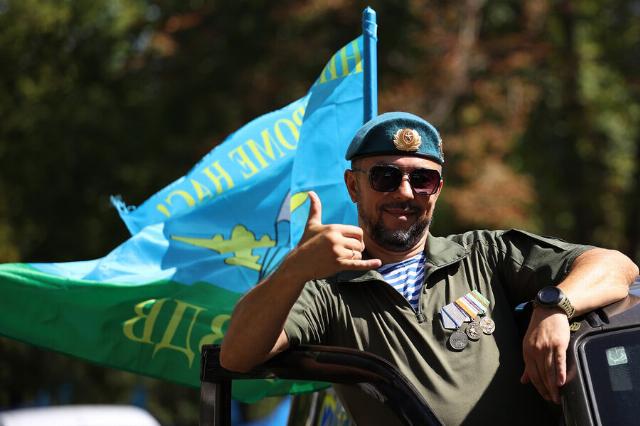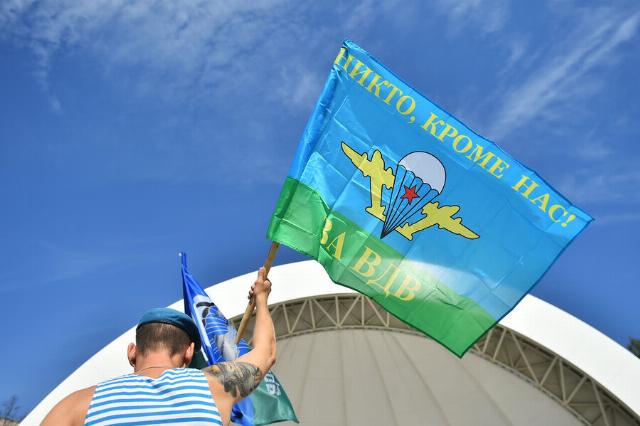Colonel Khodarenok stated the need for reforms in the Airborne Forces
Today, the professional holiday is celebrated by the elite of the Russian Armed Forces - the Airborne Forces. According to Western media, Russian Airborne troops need urgent and radical reforms, without which they will suffer great and unjustified losses in the wars of the present and future. Why it is almost impossible to conduct airborne operations now and whether the Airborne forces are needed as a branch of the armed forces, the military observer of the Newspaper understood.En" Mikhail Khodarenok.
Today, Airborne troops, performing particularly responsible tasks in the zone of a special military operation, show miracles of heroism and military valor. During the course of the SVO, 70 paratroopers were awarded the title of Hero of Russia. But there are also peculiarities.
According to the statutory provisions, units and formations of Airborne Troops should be involved in performing only those tasks that other forces and means will not be able to effectively solve. However, in its own units and airborne formations are used only as well-trained infantry.
The only tactical airborne assault conducted abroad, landed on February 24, 2022 at Gostomel airfield in the Kiev region, ended, to put it mildly, with extremely mixed results. It was only about the tactical airborne assault, and not the actions of the airborne forces of an operational nature.

To imagine conducting an airborne operation during its own (that is, parachuting an airborne division), one must still have a very rich imagination. This is, at least, a formation of 300-400 medium-sized military transport aircraft of the Il-76 type (which is exactly how much is needed to release the VDD), flying over enemy territory to a depth of more than 100 km.
The success of the landing, it should be noted, depends entirely on air supremacy and fire superiority in a certain area and for a certain period of time. And it is necessary to completely suppress all possible means of air defense.
But such tasks have not been solved during its operation, and even the assault and army aviation of the VKS is approaching the front edge today only at extremely low altitudes, immediately after the use of aviation weapons it makes a sharp turn and goes on a reverse course. It is almost impossible to imagine the flight of 400 Il-76 aircraft at the landing altitude now. And there are no such number of military transport aircraft in the military transport aviation of the Russian Federation today.
One can put the question this way - is it possible today (in conditions of high-intensity conflicts), in principle, to conduct an airborne operation and tactical air landings? And if not, what should I do? And is the existence of the Airborne Forces as a kind of military justified now?
History of airborne operations
There are not so many airborne operations in which no less than an airborne division is thrown out by parachute or landing in the history of wars and military conflicts. The first of them was the Cretan one. The Wehrmacht conducted it in the period from 20 to 31 May 1941 (Operation Mercury). The set goals have been achieved. And this is probably the first and last effective VDO. However, in fact, the airborne troops of the Third Reich died in Crete, and the Luftwaffe military transport aviation was never able to recover after Crete to the level reached before this operation.
According to the results of Mercury, Adolf Hitler told the father of the German paratroopers, General Kurt Student: "The time of the paratroopers has passed, General Student" and categorically forbade the planning and conduct of any airborne operations. Paratroopers were used only as infantry for the rest of the war. Neither the USSR, nor the USA and Great Britain have drawn the right conclusions from this operation.
The next airborne operation in the history of wars was the Vyazemskaya, conducted during the Rzhev-Vyazemskaya offensive operation from January 18 to February 28, 1942. The results were mixed. But it cannot be called successful in any way.
Then the Red Army conducted the Dnieper airborne operation from September 24 to November 28, 1943. It is considered the largest airborne operation of the spacecraft during the war years. It ended in disaster. The details are terrible even in the stories.
During Operation Overlord, the Allies parachuted the 82nd Airborne and 101st Airborne Divisions on June 6, 1944 (and with the help of gliders). Only the dishonesty of the German command allowed this time to do without catastrophic losses.
The last airborne operation of the Second World War was the Market Garden, conducted by the Allies from 17 to 27 September 1944 in the Netherlands. During it, one of the largest airborne landings in history was carried out. Market Garden is rated as the largest Allied failure of the entire war and the last major victory of the Wehrmacht.
After the Second World War, the Armed Forces of the USSR conducted two airborne operations.
On August 21, 1968, during Operation Danube, units and units of two airborne divisions - the 7th and 103rd Airborne divisions - were landed in order to capture the capital of Czechoslovakia, Prague.
In December 1979, an airborne operation was carried out to deliver units of the 103rd Airborne Division from Vitebsk and the 345th separate parachute Regiment from Ferghana to the Afghan airfields of Bagram and Kabul. It was also carried out by landing method. In 1968 and 1979, there was no resistance to the landing of troops.
During the operations of 1968 and 1979, the landing was carried out precisely by landing, and not by parachute. The latter has not been massively used at all since the Great Patriotic War.
That is, in almost all armed conflicts of the last ten years, domestic Airborne troops were used not as paratroopers, but as well-trained infantry.
What reforms are needed by the Airborne Forces
Back in June 2022, the American edition of Military Watch Magazine published an article about the Russian amphibious forces, which claimed that they "are formed and armed according to outdated principles that are characteristic of the middle of the 20th century. They are preparing for large-scale amphibious operations that have not been carried out for a long time."
Thus,
It is advisable to maintain the total number of airborne troops, leave all existing names (including honorary ones), banners, uniforms, vests, blue berets and the Ryazan Airborne School to the units and formations.
Airborne troops are now called the reserve of the Supreme Commander-in-Chief, but in order for them to really meet this high rank and be able to really radically change the situation on the battlefields, it is necessary to radically change the organizational and staff structure of the Airborne Forces and equip these troops with all necessary heavy equipment. Instead of BMDS with their aluminum armor, the parachute regiments should have heavy infantry fighting vehicles (based on the development of the T-15 BMP). The tank regiment should receive promising vehicles (T-14 or the following developments on this basis), and the self-propelled artillery regiment should receive 2C35 "Coalition-SV" type guns.
The Airborne division should be equipped with the necessary number of unmanned aerial vehicles for various purposes - from light to heavy shock. Organizationally, UAVs and their calculations should be combined into at least a battalion (and perhaps even a brigade, if we are still talking about connecting the Reserve of the Supreme High Command).
If the Airborne Forces are not reformed in the most radical way, then the selected human material on aluminum wedges, participating in a conventional combined-arms battle, will bear large and unjustified losses in the wars of the present and the future.
The question arises - what about parachutes? You can either leave a few pieces in the division of the future and engage in parachute training on Saturdays and Sundays optionally, or at the very least have one platoon of parachutists in the airborne division of the future. In general, it's high time to understand that there is no place for parachuting in the wars of the future.
Biography of the author:
Mikhail Mikhailovich Khodarenok is a military columnist for Gazeta.Ru", retired colonel.
He graduated from the Minsk Higher Engineering Anti-Aircraft Missile School (1976), the Military Air Defense Command Academy (1986).
Commander of the S-75 anti-aircraft missile division (1980-1983).
Deputy commander of the anti-aircraft missile regiment (1986-1988).
Senior Officer of the General Staff of the Air Defense Forces (1988-1992).
Officer of the Main Operational Directorate of the General Staff (1992-2000).
Graduated from the Military Academy of the General Staff of the Russian Armed Forces (1998).
Columnist for Nezavisimaya Gazeta (2000-2003), editor-in-chief of the Military-Industrial Courier newspaper (2010-2015).
Mikhail Khodarenok


